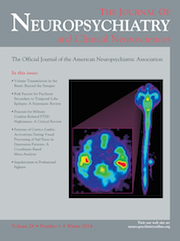Mirror Visual Feedback for Right–Left Discrimination in a Patient With Developmental Gerstmann Syndrome
To the Editor: Gerstmann described a syndrome that included finger agnosia, right–left disorientation, agraphia, and acalculia,1 and was related to cerebral vascular disease, traumatic brain injuries, neurodegenerative disease, and other miscellaneous causes.2 Developmental Gerstmann syndrome (DGS) has also been described in those who are challenged with writing and mathematical exercises in childhood, adolescence,3–5 and even in military service.6 Here, we report the use of mirror visual feedback for management of right–left disorientation in a patient with DGS.
Case Report
“Mr. Z,” a 23-year-old male soldier, second-born, and without delay in his motor and language milestones, was admitted to our psychiatric ward. He showed great difficulty in performing military tasks that required left–right discrimination, resulting in anxiety and depression. He could not recognize or name his index, middle, and ring fingers. His elementary school teacher had given remedial education so that he could do basic, but not complex calculations. He deserted three times, was court-martialed, and spent a total of 19 months in jail. Neuropsychological assessment revealed that he read and drew slowly, wrote incorrectly with phonograms, calculated in a special way, and also had right–left disorientation. The Wechsler Adult Intelligence Scale–Revised showed Full-Scale IQ: 66, Verbal IQ: 71, and Performance IQ: 73. Brain computerized tomography (CT) showed no abnormality. Developmental Gerstmann syndrome was diagnosed.
Daily remediation 5 times/week was given. During the first and second weeks of his hospital stay, a dressing mirror was used to help him recognize his own right and left hands. He slowly learned to make the correct response when asked to raise his own left or right arm. In the second phase, the psychiatrist sat opposite and demonstrated by raising his own arms. A short slogan such as “The correct response is on the opposite side” was taught. After repetitive training, and with patience, he slowly learned to make the correct response when asking to raise his left or right arm, and follow right-or-left directions and rotations correctly most of the time. He was discharged from the Army after this evaluation and treatment.
Discussion
For Mr. Z, as with other cases, an alternative strategy was developed to “bypass” patients' deficits by enhancing their strengths in learning achievement5 or cognitive ability7 for basic calculations. Preschoolers learn right–left discrimination from instruction, verbal repetition, and fine motor and gross motor treatments,8 but Mr. Z’s right–left disorientation was overlooked.
Mirror boxes could be used for visual feedback to restore brain function as part of the treatment for phantom limb pain, hemiparesis after a stroke, and complex regional pain syndrome.9 In our case, we used a dressing mirror to help the patient recognize right from left. The action may help to reverse cortical disorganization.
One hopes that simple mirror visual feedback could become a way to restore right–left orientation and help DGS patients deal with that problem and develop better social adaptation skills.
1 : Some notes on the Gerstmann syndrome. Neurology 1957; 7:866–869Crossref, Medline, Google Scholar
2 : The enigma of Gerstmann’s syndrome revisited: a telling tale of the vicissitudes of neuropsychology. Brain 2010; 133:320–332Crossref, Medline, Google Scholar
3 : Developmental Gerstmann syndrome. Neurology 1970; 20:293–298Crossref, Medline, Google Scholar
4 : Dyscalculia and elements of the developmental Gerstmann syndrome in school children. Cortex 1978; 14:197–206Crossref, Medline, Google Scholar
5 : Developmental Gerstmann syndrome: case report and review of the literature. J Dev Behav Pediatr 1987; 8:229–232Crossref, Medline, Google Scholar
6 : Developmental Gerstmann syndrome in a young Taiwanese male: a case report. Prog Neuropsychopharmacol Biol Psychiatry 2009; 33:1275–1276Crossref, Medline, Google Scholar
7 : Does finger training increase young children’s numerical performance? Cortex 2008; 44:368–375Crossref, Medline, Google Scholar
8 : Spatial concept learning in preschool children: motoric experiences and verbal repetition as adjuncts to passive listening. Percept Mot Skills 1980; 50:183–186Crossref, Medline, Google Scholar
9 : The use of visual feedback, in particular mirror visual feedback, in restoring brain function. Brain 2009; 132:1693–1710Crossref, Medline, Google Scholar



